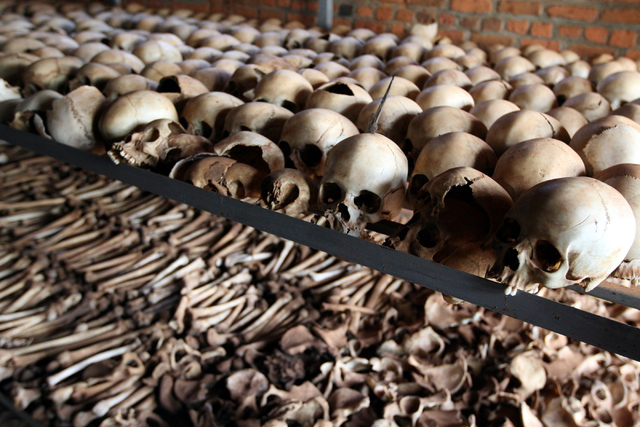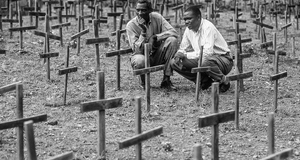From Cornell International Affairs Review VOL. 4 NO. 2Mass Killing: Politics By Other Means
By
Cornell International Affairs Review 2011, Vol. 4 No. 2 | pg. 1/1
IN THIS ARTICLE
KEYWORDS
Mass killing (often carried out in the form of genocide) offends the sensibilities of many people around the world. It is considered a "crime against humanity," such is its barbarity and ruthlessness. When it occurs, the question often asked by both victims and bystanders is, "Why?" I argue in this paper that mass killing is not, as is often portrayed, the result of primal bloodlust or racism. Through an examination of the Third Punic War, the Boer War, World War II, and the Rwandan genocide, I show that mass killing is actually carried out as a rational means to a political end; that is, it is simply politics by other means. If mass killing is a combination of politics and lethal violence, however, can it be called war? I argue that mass killing, while bearing similarities to and often occurring simultaneously as warfare, is nonetheless different from war because it does not require multiple sides actively fighting each other, as war does. Is mass killing the deliberate and indiscriminate killing of non-combatants politics by other means and, if so, is it the same as warfare? In this paper, I argue that mass killing is simply politics by other means, that it is a procedure used to effect an ideological or political policy. Examining historical case studies, I show that mass killing is a calculated, rational means to an end. I also argue, however, that mass killing is not the same as warfare, since mass killing targets non-combatants and does not require opposing forces. Mass Killing as PoliticsMy first case study, of Rome and Carthage, demonstrates that mass killing has a long history and is not unique to the modern era. After the Third Punic War, Rome reduced Carthage to rubble, sowed the fields with salt to ensure nothing could be grown, killed the men, and sold the women and children into slavery. The Carthaginian civilization ceased to exist. This was not done out of bloodlust or plunder, though that surely did occur; Rather, Rome was reacting to an economic and political rival that was also geographically threatening. In the previous Punic War, Hannibal had roamed through Italy for seventeen years, plundering the inhabitants and killing a generation of Romans. To ensure national security, Rome had to permanently end its gravest threat. The Third Punic War had to be the last of its kind. Thus, mass killing is not unique to the modern era, where it has continued as an instrument of policy. At the cusp of the twentieth century, for example, the United Kingdom imprisoned 120,000 Boers in concentration camps. Twenty-eight thousand Boers died, and 86 percent were under the age of sixteen). The United Kingdom enacted this policy to undermine the morale of the Boer fighters and to deny them aid, comfort, family, food, and home. British soldiers did not do this because they intrinsically hated Boers; rather, concentration camps aided the British war effort by pressuring the Boers to surrender. Locking up families and starving them to death was part of a policy, not the result of primitive, blind hatred. Like Rome before, Britain used and abused non-combatants to further policy. As the twentieth century progressed to its midpoint, World War II illustrated the continued use of mass killing as policy. Japan's brutalities, though numerous, were conducted not out of spite, but because of policy. Unit 731 in Manchuria conducted lethal experiments on non-combatants for scientific knowledge. The unit amputated limbs, injected diseased pushed victims to the limits of physical pain and endurance for the benefit of the Japanese military; and exposed victims to biological and chemical weapons to test their efficacy. Though it was cruel and barbaric, the scientific utility of the experiments was confirmed when the United States granted the unit immunity in exchange for the experiments' findings. In Germany, Nazi atrocities were also a result of state policy. The entire Holocaust ultimately was the result of the Final Solution, the German national goal of exterminating the Jewish racs. Likewise, mass killing of other ethnic minorities, homosexuals, and the disabled, were part of Germany's plan to ensure the "purity" of the Aryan race. Gas chambers were a rational way to accomplish that, as were army units in lead columns that doubled back to kill non-combatants. Germany pursued Aryan domination by killing non-Aryans. The United States and the United Kingdom also targeted non-combatants as policy. It was thought that massive bombardment of non-combatant populations would sap morale and cause those populations to demand that their governments sue for peace: "[T]here was no question, in the minds of the British and American advocates of strategic bombardment at least, that that was the quick and efficient road to victory."2 In Europe, the Royal Air Force killed 593,000 German civilians in the last three years of the European war,3 while America's strategic bombardment of Japan killed 300,000 civilians.4 As the war in the Pacific continued, U.S. policy became one of ending the war with as few American casualties as possible. Nuclear devices were used, killing a further 100,000 in Hiroshima and Nagasaki.5 Here was industrialscale mass killing to effect government policy. The mass killing seen by all actors in World War II culminated in two bombs that wiped out two cities and hundreds of thousands of noncombatants. A final illustration of mass killing as government policy is the Rwandan genocide at the end of the twentieth century. Fergal Keane writes: "The killings . . . were planned long in advance by a clique close to President [Juvénal] Habyarimana himself. This clique . . . bitterly resented the prospect of power-sharing with the Tutsi minority. Any democratization of Rwanda's effective one-party state would have had disastrous consequences for the clique."6 Unwilling to share power, the Hutu government unleashed a propaganda campaign, telling Hutus that Tutsis were a danger and that they would return to colonial and pre-colonial times and make Hutus "beasts of the field once again."7 Mass killing became a way for the state to consolidate power — power cannot be shared with a population that does not exist. While there may have been individual Hutus whose hatred towards Tutsis motivated killings, their actions were merely part of a broader government policy to eliminate a specific people from the state. Rather than expel Tutsis, as Idi Amin did to the South Asian populatios in Uganda, the Hutus chose the bloodier path of extermination. Their process was grotesque and inhumane, but politically rational, organized, and planned. Keane highlights the organization and foresight of the Hutus when describing the compilation of Tutsi lists, the complicity of Sylvestre Gacumbitsi.8 The government broadcasts of anti-Tutsi propaganda, the Tutsi identification system, and the use of Interahamwe militia all facilitated Tutsi killings. Tutsis, therefore, perished for a political cause espoused by the state. The four case studies thus show that acts of mass killing have been perpetrated throughout the course of history and are not phenomena unique to the Industrial Age, when machines made murder more efficient. Mass killing is carried out by liberal democracies, not just by totalitarian regimes. However, no matter when mass killing is carried out or by whom, it has ocurred as a governmental policy, a rational (i.e., logical) means to a political end. Is Mass Killing War?Mass killing is thus politics by other means, but it is not the same as war, because there are no forces actively fighting each other; there exists just one force imposing its will. War, as Carl von Clausewitz writes, "is nothing but a duel on a larger scale." He states: "Each tries through physical force to compel the other to do his will."9 For war to transpire, then, there needs to be a minimum of two opposing forces. In mass killing, there is no such requirement, due to the nature of non-combatants. Armenians did not actively resist the Turks. Jews did not actively resist the Germans. Japanese non-combatants did not actively resist Americans. The same applies to the cases of the Germans and the British. Tutsis hid in churches. Indeed, Mass killing may occur most often in wartime, as in Baghdad in 1258 or Bosnia in 1994, but that may be because these two policies are complementary. They are not inherently the same. Mass killing is not a duel between forces actively opposing each other. It is a onesided affair in which one force exterminates a second force that cannot resist. Mass killing is a rational policy inflicted upon those who do not fight back. War is a rational policy inflicted upon those who do fight back. CounterargumentsOne counterargument to make is that I have confused the victim for the process, that it does not matter who is killed, so long as the act of killing is the same. I argue, however, that the nature of the victim is paramount, because as Clausewitz noted, war is a duel. If the person killed was not armed and was not seeking to kill in return, then it was not a duel. The absence of reciprocal violence is acknowledged by normative language. If there were no difference between targeting non-combatants and targeting combatants, we would not need phrases like "genocide," "collateral damage," or "strategic bombing." We would simply use the word "war." Mass killing is this politics by other means, but it is not the same as war, because there are no forces actively fighting each other. A second counterargument requires me to explain how mass killing and warfare could occur so often within the same historical period if they are not the same. Such critics confuse complementarity with sameness. If this critique were correct, then one would have to call the Tiananmen Square Massacre a war and the Six-Day War a mass killing. This would stretch the definition of war to a uselessly broad extent, like the "war" on poverty. I would also note that not every war has seen mass killing, and not all mass killings have occurred in wars. Even if wars and mass killings only occur together, such a relationship would only prove correlation, not sameness or causation. A final counterargument is that mass killing is not policy by other means, but merely the bloodlust of crazed psychopaths. I argue that this is a gross simplification of the issue. While there are individual instances of killing for killing's sake, the history of mass killings, including those examined here, show that they are done in fulfillment of a rational objective.10 Examined at a societal, rather than individual, level, one sees that mass killing has a practical purpose. Ultimately, ideological justifications for mass killing tend to mask more practical motives. ConclusionMass killing, however cruel, undeserved, inhumane, and offensive, is a rational, calculated, policy-driven means to some end. It is one of many ways to implement a policy. However, there is no transitive effect between mass killing, warfare, and policy by other means. Mass killing may be policy and war may be policy, but this does not mean that mass killing is necessarily war. Killing unarmed people is fundamentally different from killing armed people. While both actions may be complementary, and doing either constitutes policy, only the latter is warfare. ReferencesClausewitz, Carl von. On War. Edited and translated by Michael Howard and Peter Paret. Princeton: Princeton University Press, 1976. Dower, John W. War without Mercy: Race and Power in the Pacific War. New York: Pantheon Books, 1986. Dyer, Gwynne. War. New York: Crown, 1985. Keane, Fergal. Season of Blood: A Rwandan Journey. London: Penguin, 1995. Valentino, Benjamin A. Final Solutions: Mass Killing and Genocide in the 20th Century. Ithaca: Cornell University Press, 2004. Endnotes
Photos courtesy of: Suggested Reading from Inquiries Journal
Inquiries Journal provides undergraduate and graduate students around the world a platform for the wide dissemination of academic work over a range of core disciplines. Representing the work of students from hundreds of institutions around the globe, Inquiries Journal's large database of academic articles is completely free. Learn more | Blog | Submit Latest in Political Science |



















